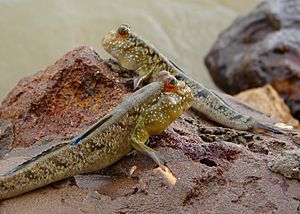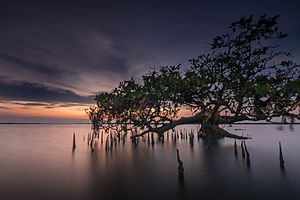Semi-aquatic facts for kids



Imagine an animal that loves to swim but also enjoys a walk on land. That's a semi-aquatic animal! These amazing creatures spend part of their lives in water and part on land. They have special adaptations that help them survive in both places. It's like having two homes!
Semi-aquatic animals can be found all over the world, from tiny insects to large mammals. They live in many different watery places like rivers, lakes, ponds, swamps, and even along the seashore.
Contents
Who are the Semi-Aquatic Superstars?
Many different types of living things are semi-aquatic. Let's explore some of them!
Incredible Insects
Some insects start their lives in water and then move to land or air.
- Dragonflies: Did you know that baby dragonflies, called nymphs, live underwater? They breathe with gills, just like fish! When they grow up, they crawl out of the water, shed their skin, and fly away as beautiful adult dragonflies.
- Whirligig Beetles: These cool beetles are often seen spinning around on the surface of ponds or slow-moving streams. They can dive underwater to escape danger or find food, but they spend most of their time zipping around on top.
Amazing Amphibious Fish
Most fish live only in water, but some are special!
- Mudskippers: These fish are true adventurers! They can "walk" on land using their strong fins and even breathe air through their skin and special gill chambers. Mudskippers love to hang out in muddy swamps and tidal flats, especially in places like Africa and Asia. They can stay out of water for a long time, looking for food or even climbing trees!
Terrific Tetrapods
Tetrapods are animals with four limbs, like mammals, birds, reptiles, and amphibians. Many tetrapods spend a lot of time in water.
- Amphibians: The word "amphibian" means "double life," and it's perfect for these animals!
- Frogs and Toads: Most frogs and toads lay their eggs in water. Their babies, called tadpoles, live entirely in water and breathe with gills. As they grow, they develop lungs and legs, allowing them to live on land, though they still need to keep their skin moist.
- Salamanders and Newts: These slender amphibians also have a watery start to life. Many adult salamanders and newts live near water, returning to it to breed. Some species spend almost all their lives in water, while others are more land-based but still need damp environments.
Cool Crustaceans
Crustaceans are a group of animals that includes crabs, lobsters, and shrimp.
- Shore Crabs: Many crabs live along the seashore, where the tide goes in and out. They are experts at living both in the water and on the wet sand or rocks. They can breathe underwater using gills, but they also need to be able to move around on land to find food or hide. The Pachygrapsus marmoratus is a great example of a crab that lives near the water's edge.
Super Spiders
You might think all spiders live on land, but some are semi-aquatic!
- Fishing Spiders: Spiders like Dolomedes minor are often called "fishing spiders." They live near water and can actually walk on the water's surface! They are very good at catching insects that fall into the water or even small fish and tadpoles near the edge. They can even dive underwater for a short time to escape danger or catch prey.
Plants that Love Both Worlds
It's not just animals! Some plants also live in both water and on land.
- Water Lilies and Lotuses: These beautiful plants have roots in the mud underwater, but their leaves and flowers float on the surface or stand tall above the water. They are specially adapted to get nutrients from the water and sunlight from the air.
- Mangrove Trees: These amazing trees grow in salty coastal waters, often where rivers meet the sea. They have special roots that help them breathe even when they are covered by water, and they can filter out salt from the water. Mangroves are super important for protecting coastlines and providing homes for many animals.
Images for kids
-
Hunting stance of Dolomedes minor, a semiaquatic spider



